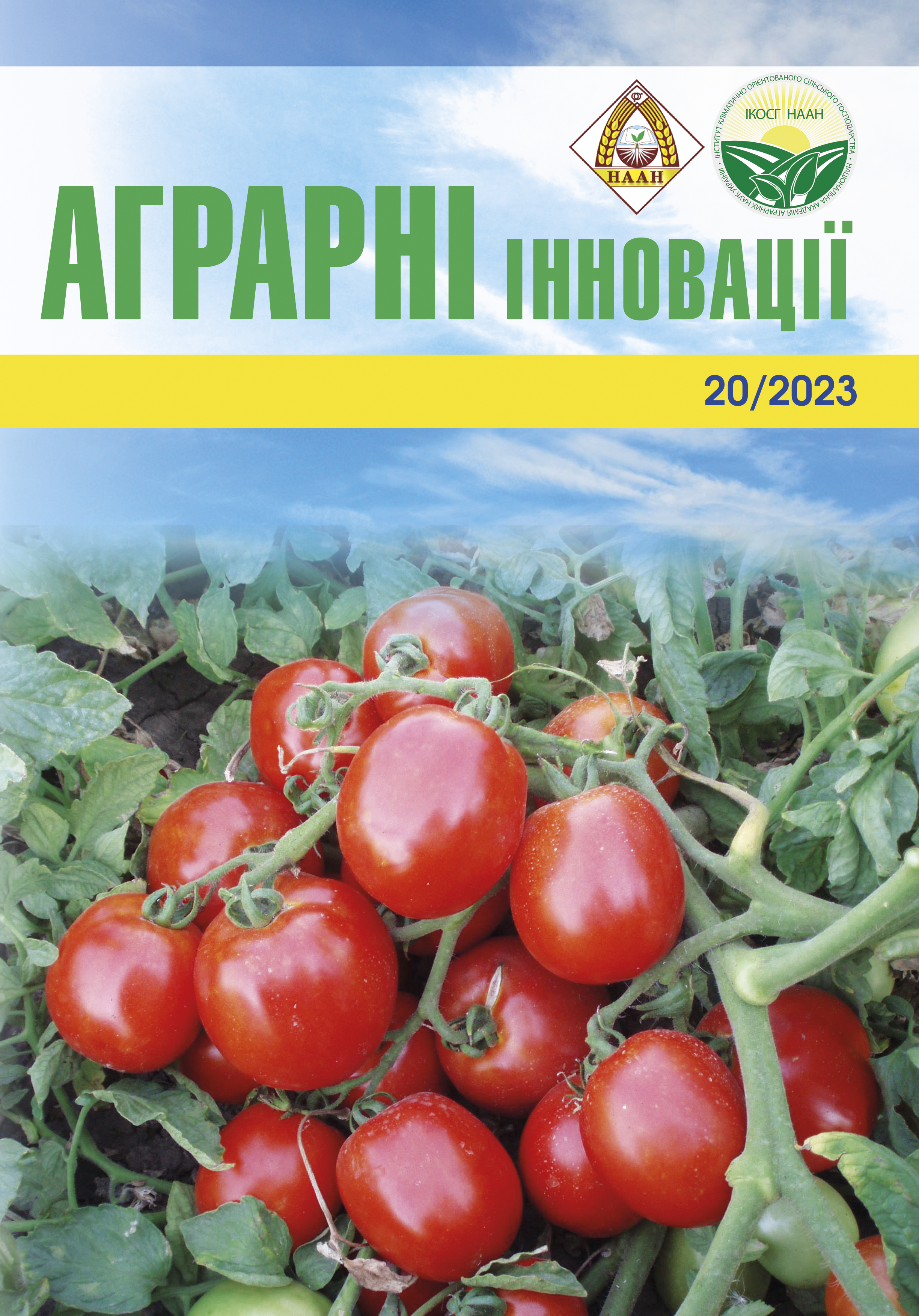Justification of the monitoring of the South American tomato mother (Tuta absoluta Meyr.) by pheromone traps in the Steppe of Ukraine
Abstract
The innovative aspect of the research lies in justifying a contemporary monitoring strategy for the South American tomato moth, Tuta absoluta Meyr. The study highlights the biological and ecological characteristics of the phytophage, which appeared in the research region in 2010. In 2012, the spread of the pest was detected on an area of 79 hectares in the Kherson region, and in recent years, its presence has been noted on tomatoes in the Mykolaiv and Zaporizhia regions. The presence of the phytophage in Southern Ukraine underscores the importance of developing and implementing moth monitoring in production with the use of modern pheromone traps. Notably, in 2018, the State Food and Consumer Service (under the Ministry of Agrarian Policy and Food) recorded 18 cases of pest detection in imported vegetables brought to Ukraine from Turkey, Spain, Egypt, and Morocco. The pest also spreads with seedlings, packaging materials, soil, and containers. According to the Department of Phytosanitary Safety and Control in the Field of Seed Production and Nursery (part of the State Service of Ukraine for Food Safety and Consumer Protection), as of December 1, 2018, the area inhabited by the tomato moth on the territory of Ukraine was 829.92 hectares. The aim of the research was to investigate the periods of highest pest prevalence in order to promptly respond and implement proper measures for protecting tomatoes and preserving crop quality. To develop quarantine strategies, the morphological and ecological characteristics of the pest were studied. Following the standard methodology, an inspection was conducted, primarily focusing on the extent of pest damage in tomato fields. The degree of damage in the upper and middle layers of generative organs formation was determined. Special attention was paid to the concentration levels in these parts using pheromone monitoring, including the «Delta» trap and the modern pheromone trap.
References
2. Наказ Міністерства аграрної політики та продовольства України № 397 від 16.07.2019 р. «Про внесення змін до Переліку регульованих шкідливих організмів». Посилання: https://zakon.rada.gov.ua/laws/show/z087919#Text
3. Небезпечний карантинний шкідник томатів – південноамериканська томатна міль. Посилання: h t t p s : / / d p s s - k s . g o v. u a / n o v i n i / n e b e z p e c h n i j - karantinnij-shkidnik-tomativ-pivdennoamerikanskatomatna-mil
4. Клечковський Ю.Е. та ін. Південноамериканська томатна міль: фітосанітарний моніторинг та захист томатів в умовах Одеської області. Карантин і захист рослин. 2015. № 6. С. 12–14.
5. Прищепа Л.І., Войтка Д. В. Біологічний контроль томатної молі. Захист і карантин рослин. 2013. № 4. С. 39–42.
6. Захист рослин. Терміни та визначення відповідно до ДСТУ 4756:2007 [Чинний з 2007-04-04]. – К. : Держспоживстандарт України, 2008.
7. Федорчук М.І., Миколайчук В.Г. Методичні рекомендації з методики використання феромонних пасток для моніторингу комах-шкідників сільськогосподарських культур для здобувачів ступеня вищої освіти «магістр» спеціальності 201 «Агрономія» денної форми навчання, Миколаївський національний аграрний університет, 2008.
8. Гордієнко О.В., Лагерєва М.В. Сезонна динаміка популяції південноамериканської томатної молі Tuta absoluta Meyr. в захищених культурах томатів на території Полтавської області.
9. Кулешов А.В., Білик М.О., Довган С.В. Фітосанітарний моніторинг і прогноз: навч. посіб. [2-ге вид.] Харків: Espada, 2011.
10. Томатна міль: подбай зараз, бо завтра буде пізно. Червень 2020 рік.
11. Zink F.A., et al. A real-time PCR assay for rapid identification of Tuta absoluta (Lepidoptera: Gelechiidae). Frida A. Zink et al. Journal of Economic Entomology. 2020. Vol. 113, Issue 3. P. 1479–1485.
12. Biondi A., et al. Ecology, worldwide spread, and management of the invasive South American tomato pinworm, Tuta absoluta: past, present, and future. Biondi A. et al. Annual Review of Entomology. 2018. Vol. 63. P. 239–258.
13. Epanchin-Niell R. S. Economics of invasive species policy and management. Biological Invasions. 2017.
14. Zhang Gui-fen et al. First report of the South American tomato leafminer, Tuta absoluta (Meyrick), in China / Zhang Gui-fen et al. Journal of Integrative Agriculture. 2020. Vol. 19, Issue 7. P. 1912–1917.
15. Simberloff D., et al. Impacts of biological invasions: what’s what and the way forward / Simberloff D. et al. Trends in Ecology and Evolution. 2013. Vol. 28.
16. Ramzi Mansour et al. Occurrence, biology, natural enemies and management of Tuta absoluta in Africa / Ramzi Mansour et al. Entomologia Generalis. 2018. Vol. 38, Issue 2. P. 83–112.
17. Pimentel D., Zuniga R., Morrison D. Update on the environmental and economic costs associated with alien invasive species in the United States. Ecological Economics. 2005. Vol. 52. P. 273–288.
18. Pheromone Traps for Monitoring Insect Pests. Alabama Cooperative Extension System. March 2013, Anr-1431.
19. Roda A. L., Brambila J., Barria J., Euceda X., Korytkowski C. Efficiency of Trapping Systems for Detecting Tuta absoluta (Lepidoptera: Gelechiidae). Journal of Economic Entomology, Volume 108, Issue 6, December 2015, Pages 2648–2654.
20. Ministry of Agriculture, Food and Rural Affairs (c). Pest Monitoring: Proper use of Pheromone Traps. February 13, 2021.






